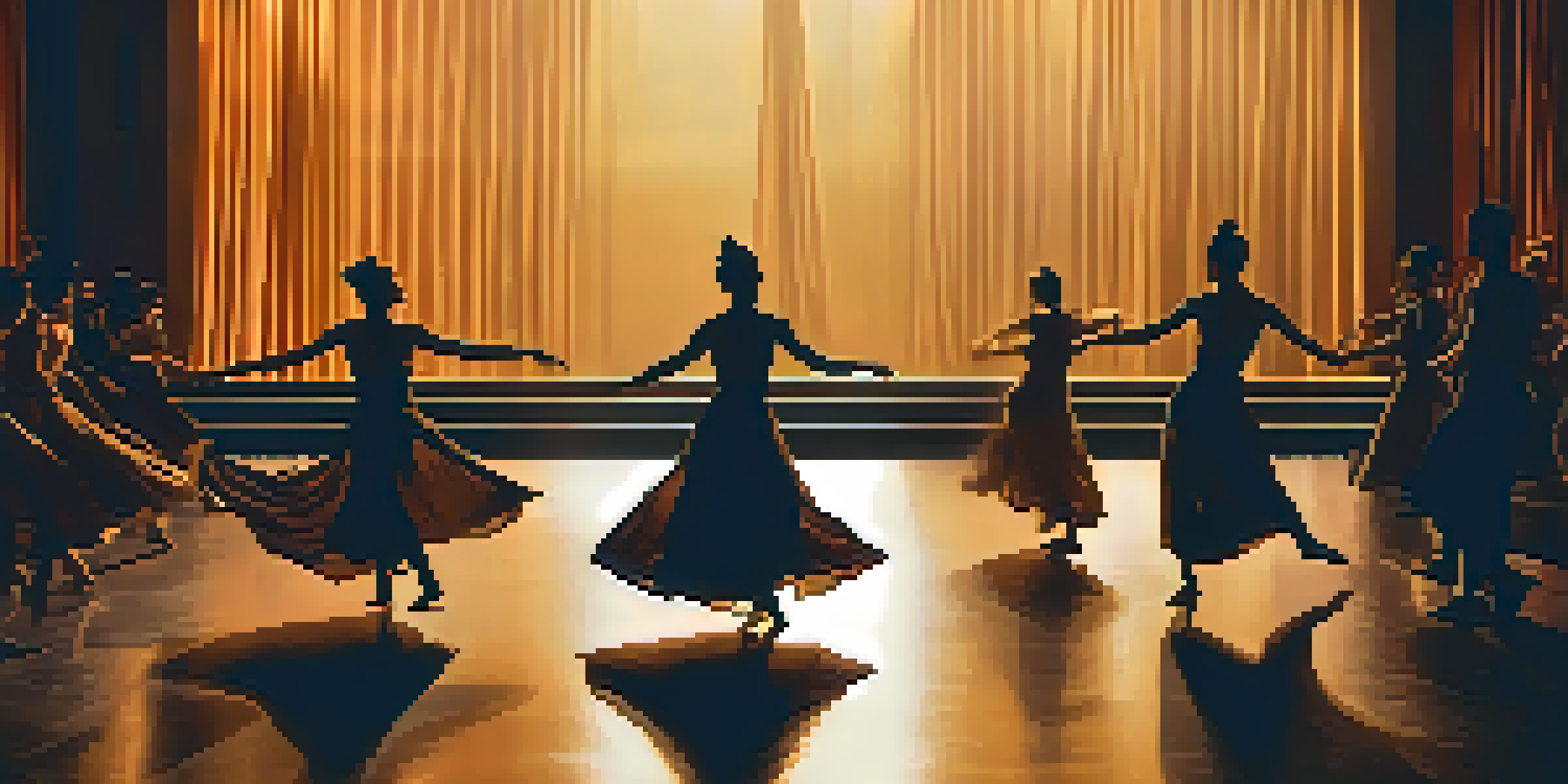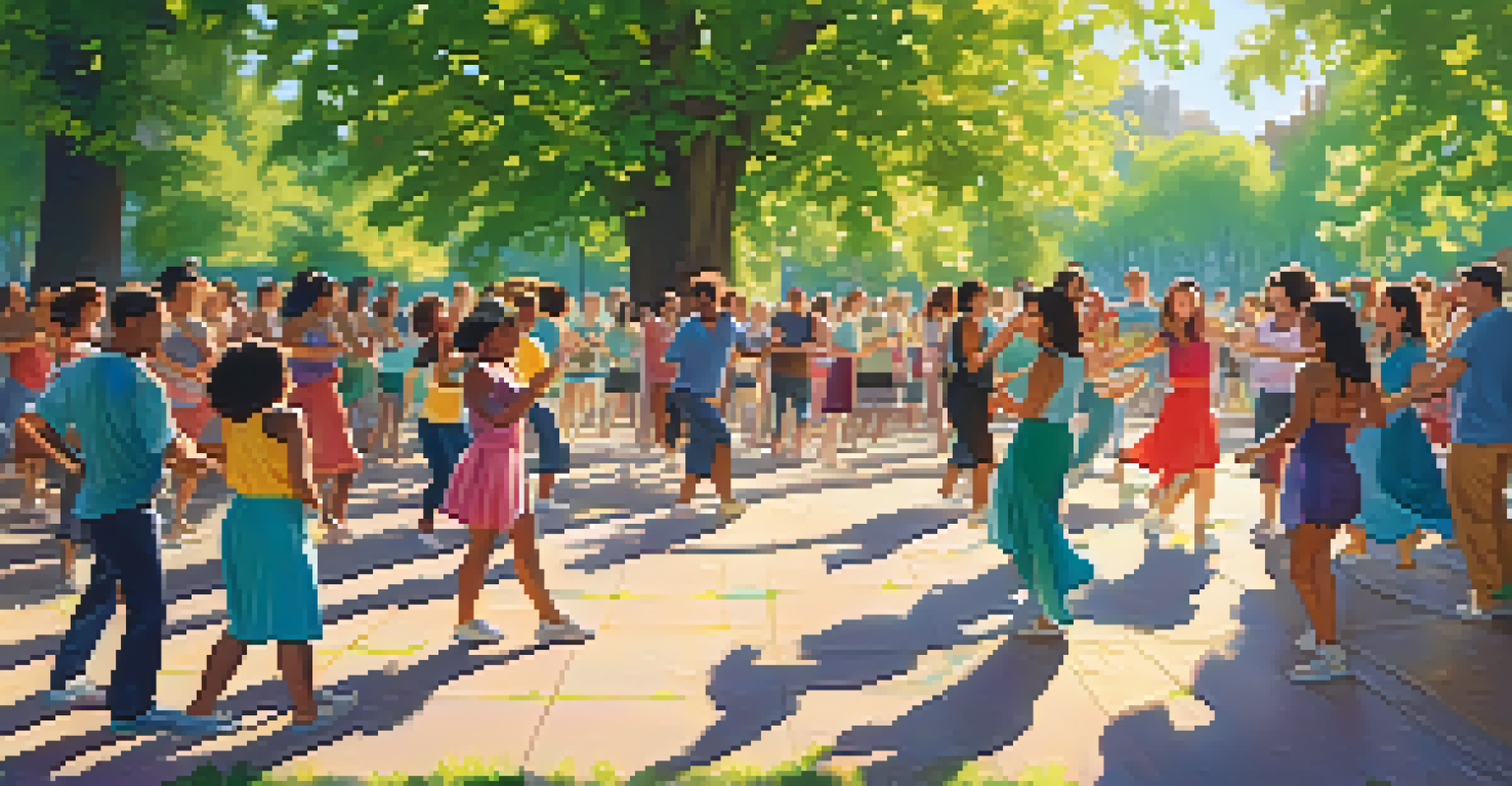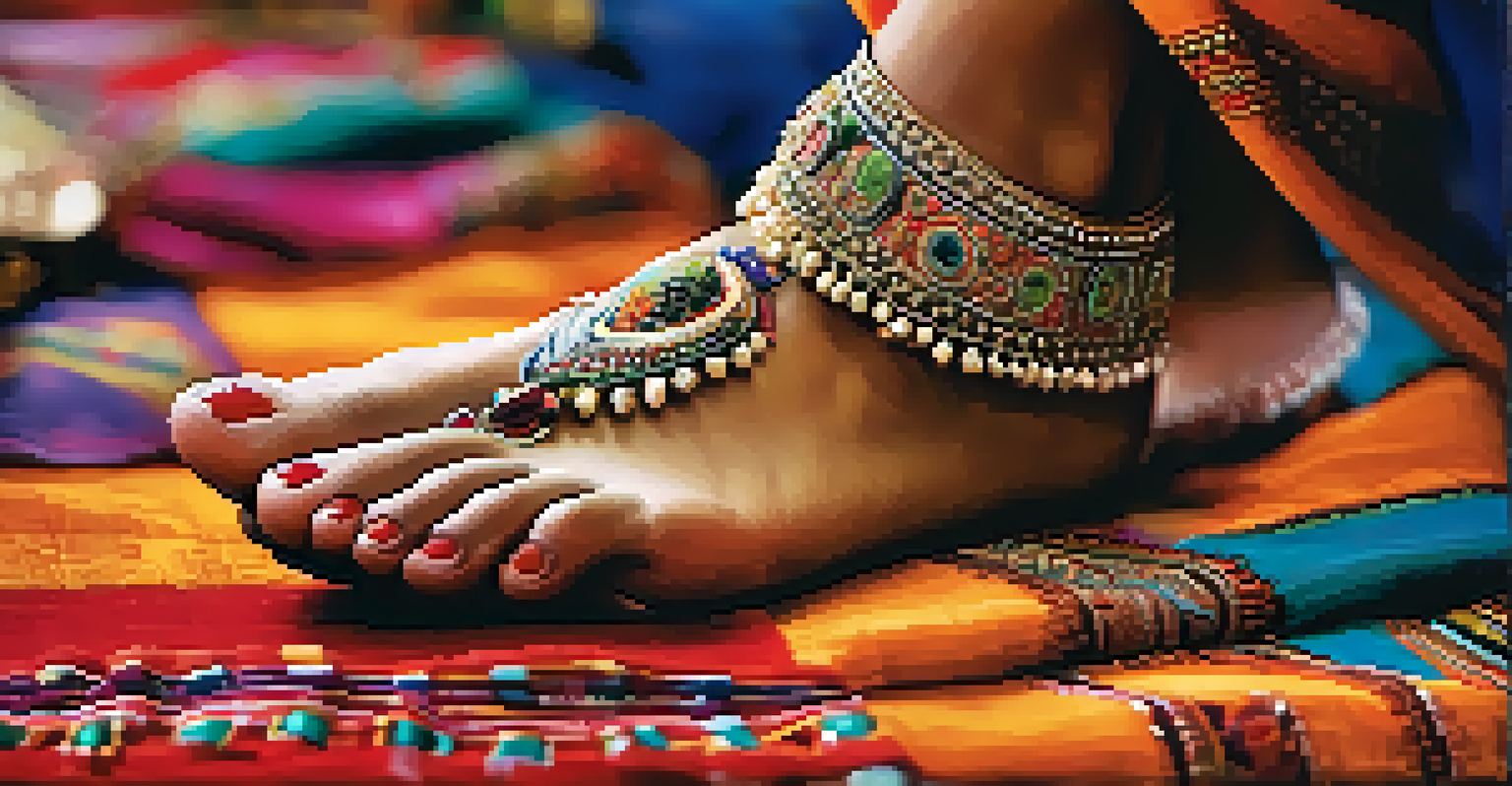Sound and Movement: Dance as a Visual and Auditory Art Form

Understanding Dance as a Multi-Sensory Experience
Dance is not just a visual spectacle; it's a fusion of sound and movement. Each step and gesture creates a rhythm that resonates with the audience, engaging them on multiple levels. This multi-sensory experience allows dancers to express emotions and narratives that words often cannot convey. Imagine a story told through body language and music, where every beat complements a movement, creating an immersive experience.
Dance is the hidden language of the soul.
The synergy between sound and movement adds depth to the performance. For instance, a contemporary dance piece may use a haunting melody that heightens the emotional intensity of the movements. Audiences find themselves not just watching the dance but feeling it, as the music and choreography intertwine seamlessly. This connection transforms the performance into a dialogue, where sound informs movement and vice versa.
As viewers, we often find ourselves tapping our feet to the rhythm or swaying to the melody, subconsciously participating in the art form. This interaction reinforces the idea that dance is not merely an observation but an invitation to feel and respond. Consequently, the experience becomes a shared journey between the dancers and the audience, enriching the overall impact of the performance.
The Role of Music in Dance: Setting the Tone
Music plays a crucial role in shaping the atmosphere of a dance performance. It sets the emotional tone, guiding both the dancers and the audience through the narrative. For instance, a fast-paced, upbeat song can inject energy and excitement into a performance, while a slow, melancholic tune can evoke feelings of introspection and sadness. The choice of music can elevate the experience, making it unforgettable.

In many dance forms, the rhythm and tempo of the music dictate the pace of the movements. Think of ballet, where dancers often adhere to classical music that complements the gracefulness of their techniques. The synchronization between music and dance creates a harmonious blend that captivates audiences, drawing them into the story being told. This unity transforms the performance into a cohesive work of art.
Dance Engages Multiple Senses
Dance combines movement and music to create a rich, multi-sensory experience that evokes emotions and tells stories.
Moreover, the diversity of musical genres allows for an exploration of different themes and emotions in dance. From hip-hop's energetic beats to the soothing melodies of contemporary dance, each style offers a unique way to express ideas and feelings. This variety enriches the dance landscape, encouraging innovation and creativity across genres, and inviting audiences to experience a spectrum of emotions.
Choreography: The Art of Combining Sound and Movement
Choreography is the blueprint for a dance performance, intricately weaving together sound and movement. A choreographer must consider how each movement interacts with music, crafting transitions that enhance the overall flow of the piece. For example, a sudden pause in music might correspond with a striking pose, creating a dramatic moment that captivates the audience's attention. This careful planning ensures that the dance resonates both visually and audibly.
Music can change the world because it can change people.
In creating choreography, artists often draw inspiration from the music itself. They may listen to a track repeatedly, allowing its nuances to inspire movements that reflect its mood and rhythm. This process can lead to innovative interpretations, where the dance embodies the essence of the music, creating a dialogue between the two art forms. Such creativity elevates the performance, making it a dynamic conversation between sound and movement.
Additionally, choreographers must be mindful of how different movements can evoke specific feelings when paired with particular sounds. A gentle sway may feel calming with soft music, while sharp, angular movements can create a sense of urgency against a fast tempo. This interplay requires an understanding of both dance and music theory, ensuring that the final piece is not only visually stunning but also emotionally impactful.
The Emotional Impact of Dance and Sound Interaction
The interaction between sound and movement in dance has a profound emotional impact on both performers and audiences. Music can amplify feelings expressed through movement, allowing dancers to convey complex emotions with greater intensity. For instance, a dancer performing to a powerful orchestral score may evoke feelings of triumph or sorrow, drawing the audience into their emotional journey. This connection makes the performance resonate long after the final note.
Moreover, the emotional responses elicited by dance and sound are often universal. Regardless of cultural background, many people can relate to the feelings expressed through movements set to music. This shared experience creates a sense of community, where audiences collectively celebrate the artistry on display. It's fascinating how a dance piece can spark joy, nostalgia, or even catharsis through its combination of sound and movement.
Music Shapes Dance Performances
The choice of music significantly influences the emotional tone and pacing of dance, enhancing the overall impact of the performance.
This emotional depth is what makes dance such a powerful art form. It transcends language barriers, allowing for a more profound understanding of human experiences. As audiences watch a performance, they are not mere spectators; they become participants in an emotional dialogue, experiencing the highs and lows alongside the dancers. This shared journey is what transforms a performance into a memorable and impactful event.
Cultural Expressions: Dance Styles Across the World
Dance is a reflection of culture, and various styles around the world showcase the unique relationship between sound and movement. From the lively rhythms of African dance to the elegant footwork of Flamenco, each style tells a story that is deeply rooted in its cultural origins. The music that accompanies these dances often embodies the traditions and history of the people, making the performance a celebration of identity.
Different cultures utilize various instruments and sounds that influence the dance movements. For instance, traditional Indian dance forms often incorporate intricate hand gestures, or mudras, that correspond with the beats of classical music. This rich interplay between sound and movement allows dancers to narrate stories that are both visually captivating and culturally significant. It highlights how dance can serve as a bridge connecting us to our heritage.
As globalization continues to influence art forms, we see a beautiful fusion of styles emerging. Contemporary dance often integrates elements from various cultural dances, creating innovative performances that transcend traditional boundaries. This blending not only broadens the scope of dance but also fosters a greater appreciation for cultural diversity, reminding us that sound and movement can unite us in celebration of our differences.
Dance as a Therapeutic Art Form: Healing Through Movement
Beyond its artistic value, dance has been recognized as a therapeutic tool that harnesses the power of sound and movement for healing. Dance therapy often encourages individuals to express emotions through movement, allowing for a release of pent-up feelings. The rhythmic quality of music paired with dance movements can help participants connect with their inner selves, promoting emotional well-being and resilience.
Research has shown that engaging in dance can reduce stress, improve mood, and enhance overall mental health. The combination of physical activity and musical engagement stimulates the brain, releasing endorphins that boost happiness. For many, the act of dancing becomes a form of self-care, providing an outlet for expression and catharsis. It's incredible how movement set to music can serve as a powerful tool for healing.
Dance as a Healing Tool
Dance therapy leverages the connection between sound and movement to promote emotional well-being and resilience in individuals.
Furthermore, dance therapy is inclusive, allowing individuals of all abilities to participate. Whether in a structured class or a casual setting, everyone can find joy in expressing themselves through movement. This inclusivity reinforces the idea that dance is a universal language, one that can bring people together, foster connection, and promote healing through the harmonious blend of sound and movement.
The Future of Dance: Innovations in Sound and Movement
As technology continues to evolve, the future of dance promises exciting innovations in the interplay between sound and movement. Virtual reality (VR) and augmented reality (AR) are beginning to transform how dance is experienced and created. Imagine a performance where audiences can interact with dancers in a virtual space, enhancing the sensory experience of movement and sound in real-time. This technological advancement could revolutionize how we perceive and engage with dance.
Moreover, advancements in sound technology, such as spatial audio, are allowing choreographers to explore new dimensions in their work. By manipulating sound in a three-dimensional space, dancers can create immersive performances that captivate the audience's senses. This innovation challenges traditional boundaries, encouraging dancers to experiment with how sound informs their movements and vice versa.

As we look ahead, the blending of dance with other art forms will continue to flourish. Collaborations between dancers, musicians, and visual artists can lead to groundbreaking performances that push the limits of creativity. These innovations inspire fresh perspectives on how we experience art, reminding us that the relationship between sound and movement is ever-evolving, and the possibilities are truly limitless.